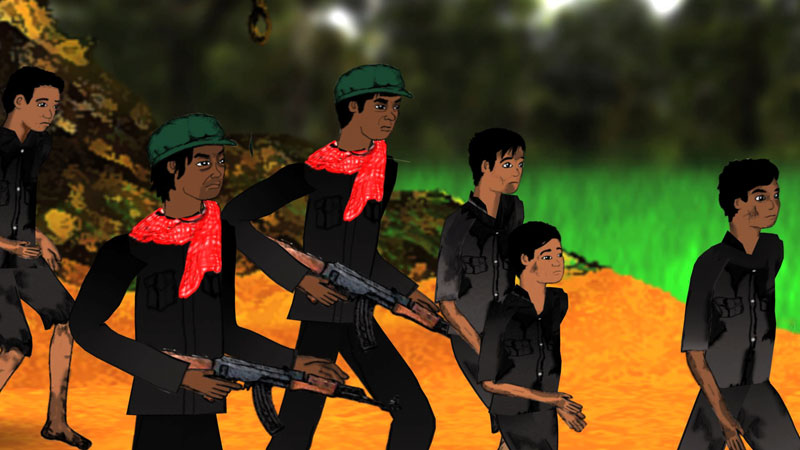Over the course of two decades, Hom Chhorn made numerous trips to Cambodia to locate the prison he had been incarcerated in during the Khmer Rouge’s reign of terror. He knew it existed, somewhere. He remembered it vividly.
“The daily routine would be to see someone being beaten up in the morning, someone had usually died by midday…. You’d see some children go to sleep and never wake up,” Mr. Chhorn, 41, said during an interview in Phnom Penh last month.

Mr. Chhorn’s parents, who were land owners and fairly wealthy, were forced to flee to Battambang City when the Khmer Rouge overran their village in Pursat province’s Phnom Kravanh district.
From what Mr. Chhorn recalls, his family was sent to the camp, known simply as “32,” around mid-1978. They were urbanites, a class distrusted by the regime for its education and Western-influenced ideas. But his mother was illiterate, which proved to be a blessing.
“Even though we were urbanites, we didn’t have any possessions and my mother wasn’t able to read or write, which helped with the KR,” he said. “That’s how we were spared in the first round of killing…they thought, ‘She’s stupid, that’s good for the revolution’ but if they’d dug a little deeper, I wouldn’t be sat here now.”
Survivors estimate that about 30,000 people perished at Camp 32, more than at the infamous Tuol Sleng prison in Phnom Penh. And according to Mr. Chhorn, roughly 150 survivors remained when the prison guards fled to the west as the Vietnamese moved closer in early 1979.
After returning to Battambang, Mr. Chhorn fled with his family to the Khao I Dang refugee camp across the Thai border before eventually immigrating with his mother to Australia, where he finished school and embarked on a career in journalism and film production.
Despite starting a new life in Australia, mental scars still plagued Mr. Chhorn and he began to research the site where he watched so many people die. In 1993, he returned to Cambodia to report on the Untac-organized elections, to begin looking for Camp 32—to no avail.
After two more failed trips to locate the site and survivors in 2000 and 2003, he decided to sit down with his mother, who was in poor health, and extract from her whatever information she could remember about the camp.
“My mother thinks I’m a stupid idiot for doing this story because she thinks nobody cares…but I said we shouldn’t let this be silent forever. There were once physical beings and they were once communicating with others, and if we choose not to talk about it, then it would be like they never existed and the KR would have won,” he said.
About six years later, in 2010, Mr. Chhorn met Australian film director Tim Purdie while working on another project. A discussion over coffee quickly turned to talk of Camp 32.
“Hom and I initially met for a coffee to talk about some video production work for a university here in Melbourne…when Hom told me about his family history, and especially the fact he believed that up to 30,000 people had been murdered at Camp 32…I offered to help Hom in any way I could,” Mr. Purdie said in an email.
Months later, Mr. Chhorn, Mr. Purdie and a small team of directors and producers traveled to Cambodia in search of the camp with little more than the name of a nearby village.
The first stroke of luck came after co-producer and researcher Gaye Miller discovered that the uncle of a boy she sponsored in Siem Reap was a cook at Camp 32. He gave the group information about the camp’s whereabouts.
The team then happened to choose a taxi driven by another survivor from the camp, who agreed to take them there.
“It just changed the whole story,” said Mr. Chhorn. “It was no longer about me searching for the camp, people knew where it was.”
He said that seeing the tamarind tree at the site, one of the only recognizable landmarks, evoked dark memories of the past, but was also cathartic.
“When I saw it, my mind sort of blocked it out and somehow there’s a gate there that says, ‘You’ve confronted what you’ve always been fearful of so now go and be a man and do what you need to do,’” he said.
“It’s painful, but I can now control the pain.”
One of the primary objectives of the film, which includes animated re-enactments of life in the prison, was to document a Khmer Rouge site that was only a detail in confessions from S-21 prisoners.
“This documentary is the only documentation of Camp 32,” he said.
Mr. Chhorn is planning a private screening of “Camp 32” in Battambang this weekend, and screenings in Melbourne and Sydney in the coming months before entering it into festivals. He hopes to start screening the film in Cambodia sometime next year.
For Mr. Chhorn, the film’s most important purpose is to ensure that those who died at Camp 32 are remembered.
“It doesn’t matter to me if it wins awards or not. What matters is that people know about the story, and about Camp 32,” he said.
“If somehow, as living beings, we give conscious thought about Camp 32, perhaps that’s what the people who perished there want.”




